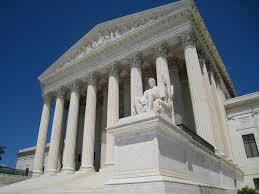U.S. Supreme Court begins hearing major Alabama voting rights fight
The U.S. Supreme Court began hearing arguments on Tuesday in a major legal battle that threatens to further undermine a landmark federal voting rights law as the state of Alabama defends a Republican-drawn electoral map faulted by judges for diluting the clout of Black voters.

- Country:
- United States
The U.S. Supreme Court began hearing arguments on Tuesday in a major legal battle that threatens to further undermine a landmark federal voting rights law as the state of Alabama defends a Republican-drawn electoral map faulted by judges for diluting the clout of Black voters. A three-judge federal court panel invalidated the map delineating the boundaries of Alabama's seven U.S. House of Representatives districts. But the Supreme Court, in a 5-4 decision in February, let Alabama use the map for the Nov. 8 U.S. congressional elections in which Republicans are trying to regain control of Congress.
The Supreme Court was hearing two consolidated cases brought by Black voters challenging the legality of the map. The dispute gives the court, with its 6-3 conservative majority, a chance to further roll back protections contained in the 1965 Voting Rights Act, which prohibits racial discrimination in voting. Tuesday will mark liberal Justice Ketanji Brown Jackson's second day of hearing arguments as a member of the court. Appointed by Democratic President Joe Biden, she is the first Black woman to serve on the nation's highest court. On Monday, she proved to be an energetic questioner, peppering attorneys with queries and follow-ups in two cases.
Conservative Chief Justice John Roberts joined the court's liberals in dissent from the February decision allowing the Alabama map to go into use, but previously has voted to limit the Voting Rights Act's reach. The lower court found that Alabama's map diminished the influence of Black voters by concentrating their voting power into a single House district even though the state's population is 27% Black, while distributing the rest of the Black population in other districts at levels too small to form a majority.
Alabama has argued that drawing a second district to give Black voters a better chance at electing their preferred candidate would itself be racially discriminatory by favoring them at the expense of other voters. If the Voting Rights Act required the state to consider race in such a manner, according to Alabama, the statute would violate the U.S. Constitution's 14th Amendment guarantee of equal protection under the law. Democratic President Joe Biden's administration and a number of voting rights groups backing the plaintiffs have said that a ruling favoring Alabama would threaten certain electoral districts in other states - for the U.S. House and state legislatures - potentially diminishing minority representation in politics.
The Voting Rights Act was enacted at a time when Southern states including Alabama enforced policies blocking Black people from casting ballots. The case centers on a Voting Rights Act provision, called Section 2, aimed at countering voting laws that result in racial bias even absent racist intent. Conservative states and groups already have successfully prodded the Supreme Court to limit the Voting Rights Act's scope. Its 2013 ruling in another Alabama case struck down a key part that determined which states with histories of racial discrimination needed federal approval to change voting laws. In a 2021 ruling endorsing Republican-backed Arizona voting restrictions, the justices made it harder to prove violations under Section 2.
Some of Alabama's supporters have told the Supreme Court that the challenges to the map are merely attempts to help the Democratic Party win elections, as Black voters overwhelmingly favor Democratic candidates. Electoral districts are redrawn each decade to reflect population changes as measured by a national census, last taken in 2020. In most states, such redistricting is done by the party in power, which can lead to map manipulation for partisan gain.
In a major 2019 ruling, the Supreme Court barred federal judges from curbing the practice, known as partisan gerrymandering. That ruling did not preclude court scrutiny of racially discriminatory gerrymandering. A decision is expected by the end of June.
(This story has not been edited by Devdiscourse staff and is auto-generated from a syndicated feed.)
ALSO READ
Muslim community members in US decline White House Iftar dinner invite: media reports
Science News Roundup: White House directs NASA to create time standard for the moon; Wide swath of US will get buggy as two cicada broods intrude and more
Science News Roundup: White House directs NASA to create time standard for the moon; Gene involved in cell shape offers clues on left-handedness
Delhi Police save lives of woman, her dog after fire engulfs house
Centrist group No Labels drops third-party White House bid










